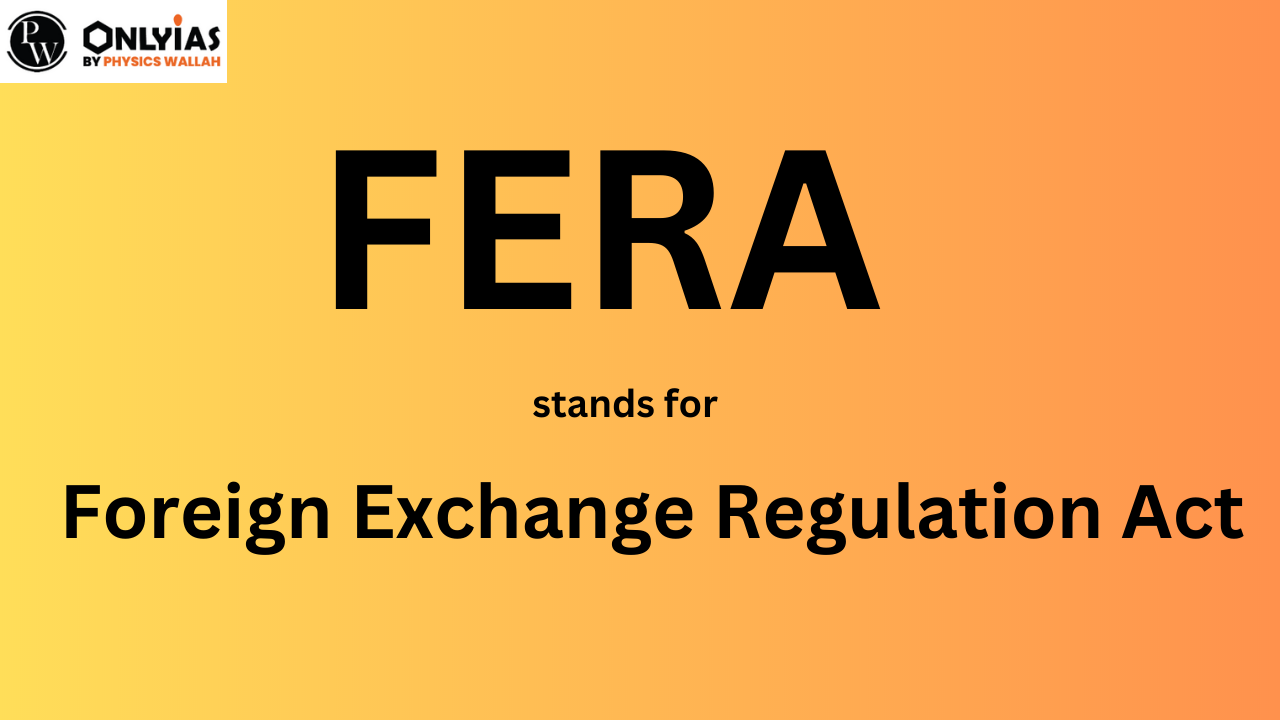![]() Ananya Gupta
Ananya Gupta
![]() September 12, 2023 03:30
September 12, 2023 03:30
![]() 3889
3889
![]() 0
0
Full form of FERA is Foreign Exchange Regulation Act. FERA was an Indian legislation enacted in 1973 to regulate foreign exchange transactions and conserve the country's foreign currency resources. It aimed to prevent unauthorized foreign currency activities and ensure the proper utilization of foreign exchange reserves.

The full form of FERA is “Foreign Exchange Regulation Act”. FERA was enacted in India in 1973 to regulate foreign exchange transactions and related matters. It was implemented as a response to concerns about the outflow of foreign exchange reserves, which were deemed essential for the country’s economic stability and growth. The act aimed to curb unauthorized foreign exchange transactions, prevent capital flight, and ensure proper utilization of foreign exchange resources.
Under FERA, various aspects of foreign exchange transactions were tightly controlled and regulated. This included the acquisition and holding of foreign currency, securities, and immovable property outside India. The act also defined the distinction between “residents” and “non-residents” based on the duration of their stay in India and applied different rules to these categories.
The Foreign Exchange Regulation Act (FERA) was an Indian law that regulated foreign exchange and certain foreign transactions in India. It was enacted in 1973 to control and manage foreign exchange dealings and preserve the country’s foreign exchange reserves. FERA aimed to prevent unauthorized transactions involving foreign currency and to ensure that the foreign exchange resources of India were utilized effectively.
| FERA Full Form | |
|---|---|
| FERA Full Form in English | Foreign Exchange Regulation Act |
| FERA Full Form in Hindi | 1973 |
| Year of Enactment | 1973 |
| Year of Repeal | 1998 |
| Focus | Regulation of foreign exchange transactions |
| Enforcement Authority | Reserve Bank of India (RBI) |
| Purpose | Conservation of foreign exchange resources |
The Foreign Exchange Regulation Act (FERA) had several key objectives, primarily aimed at regulating and controlling foreign exchange transactions in India. Some of the main objectives of FERA were as follows:
The Foreign Exchange Regulation Act (FERA) had several important features that defined its regulatory framework and impact on foreign exchange transactions in India. Some of the most significant features of FERA included:
Here are the full forms of both terms:
The Foreign Exchange Regulation Act (FERA) was an Indian legislation established in 1973 with the primary aim of controlling and overseeing foreign exchange transactions within the country. Its central objective was to regulate and safeguard India’s foreign exchange resources, ensuring their prudent utilization and preventing misuse. FERA addressed concerns regarding unauthorized foreign currency transactions, illegal transfers of funds abroad, and activities like smuggling. It bestowed the Reserve Bank of India (RBI) with the authority to monitor and manage various aspects of foreign exchange, such as currency conversions, acquisitions of foreign assets, and transactions with non-residents. FERA was characterized by its rigorous enforcement mechanisms, including substantial penalties, imprisonment, and asset confiscation in cases of non-compliance. While it played a crucial role in managing India’s foreign exchange landscape for several years, FERA eventually underwent a transformation in response to changing economic realities. In 2000, it was succeeded by the Foreign Exchange Management Act (FEMA), which introduced a more modern and market-friendly approach to foreign exchange regulations, aligning with India’s evolving economic priorities.
The Foreign Exchange Management Act (FEMA) is a significant Indian legislation introduced in 1999 to replace the Foreign Exchange Regulation Act (FERA). FEMA represents a comprehensive framework governing foreign exchange transactions, trade, investments, and related activities in India. Its primary purpose is to facilitate a more liberalized and market-oriented approach to foreign exchange regulations while still maintaining essential controls to prevent illegal activities and misuse of foreign exchange resources. FEMA streamlined and simplified procedures for foreign exchange transactions, encouraging smoother cross-border trade and investments. It provided greater autonomy to individuals and businesses in managing their foreign exchange dealings, aligning with the country’s evolving economic landscape and the global trend towards economic liberalization. Under FEMA, the Reserve Bank of India (RBI) retained its regulatory authority, ensuring the stability of India’s external trade and balance of payments, while also promoting the ease of doing business and fostering a more open environment for international transactions.
The Foreign Exchange Regulation Act (FERA) and the Foreign Exchange Management Act (FEMA) are two distinct Indian laws that govern foreign exchange transactions and related matters. Here’s a comparison highlighting the key differences between the two:
1. Time of Enactment:
2. Objective:
3. Approach:
4. Regulatory Authority:
5. Foreign Investment:
6. Authorized Dealers:
7. Residential Status:
8. Penalties and Enforcement:
9. Documentation and Procedures:
10. Bearer Securities:
11. Globalization and Liberalization:
FERA का पूरा नाम “विदेशी मुद्रा विनियमन अधिनियम” है, और यह एक भारतीय कानून था जो 1973 में पारित हुआ था। इसे विदेशी मुद्रा संदेशों और विशिष्ट विदेशी लेन-देनों को विनियमित करने के लिए बनाया गया था। इसका मुख्य उद्देश्य विदेशी मुद्रा संसाधनों की संरक्षणा करना और विदेशी मुद्रा के गलत प्रयोग या अनधिकृत गतिविधियों को रोकना था।
| Related Links | |
|---|---|
| GATT Full Form | POLICE Full Form |
| BRO Full Form | OMO Full Form |
| FEMA Full Form | |
<div class="new-fform">
</div>

Latest Comments